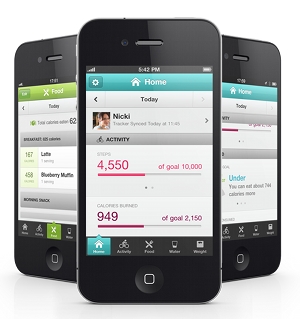Review: The FitBit One
The Fitness Device for the True Geek In All Of Us

|
BY MITAL PATEL •
@mitalpatel •
1.4.13
| |||||||||||||||||
Entrepreneurs and Investors:
Log in to ExitEvent to get a whole lot more out of it. There are hundreds of you back here.
Log in to ExitEvent to get a whole lot more out of it. There are hundreds of you back here.
Filed Under: NEWS: Technology
 I ate a lot of turkey at Thanksgiving this year. But before Christmas (and well before the new year's resolution fitness rush, I might add) I got myself a Christmas present that I've been meaning to get for quite a while now, a FitBit One.
I ate a lot of turkey at Thanksgiving this year. But before Christmas (and well before the new year's resolution fitness rush, I might add) I got myself a Christmas present that I've been meaning to get for quite a while now, a FitBit One. The FitBit One is basically a pedometer on steroids. Unlike RunKeeper or other workout apps, it tracks all of your activity, not just when you're exercising. FitBit has been producing these trackers for a few years now, and Brad Feld is notably on its Board of Directors, so it's managed to attract a lot of users from the broader startup community.
I first heard about FitBit three years ago when Nathaniel Talbot (then CEO of Spreedly) told me he was using it. Like any other geek interested in measuring and tracking almost anything, I was intrigued at the idea of gamifying personal fitness and the whole emerging concept of body augmentation and quantified self.
I think it's only a matter of time until a tracking device similar to this goes mainstream. The potential use cases are exciting, if simultaneously scary for their privacy implications. The smartphone has brought us pretty close to that reality, but it's still separate and distinct from your body.
Since Nathaniel's early model, Fitbit has gone through various product iterations and added a digital display and an altimeter to account for stairs and hills. They've clearly learned a lot and worked to integrate it into their product. I'd like to say I got one because I've gotten more serious about my health, and while that's somewhat the case, the primary reason I finally sprung for one is probably the same reason it's become so popular among other startup geeks: I'm really interested in collecting and analyzing data.
If I lose a few pounds (I could stand to do so), that'll be gravy, so to speak.
When I leave for work in the morning, I throw the FitBit One in my pocket, right next to my keys and smartphone. It sits there and tracks when I decide to take the stairs vs the elevator and credits me appropriately. It continues to track the calories I've burned and steps I've taken. When I go to sleep at night, I slip the FitBit into its wrist band and fall asleep. The FitBit One detects how long it takes me to fall asleep every night and how often I wake up in the middle of the night, giving me an idea of my overall sleep quality.
 At $99, you may not expect it to do much, but the FitBit One packs a lot of useful features and it's dead simple to use. Once it has tracked your day's activities, it syncs seamlessly via a USB dongle or via the app on your iPhone or Android smartphone. The battery holds a charge for a solid week and charges fast via a USB charging cable.
At $99, you may not expect it to do much, but the FitBit One packs a lot of useful features and it's dead simple to use. Once it has tracked your day's activities, it syncs seamlessly via a USB dongle or via the app on your iPhone or Android smartphone. The battery holds a charge for a solid week and charges fast via a USB charging cable.And you all but forget that it's in your pocket or clipped to your jeans because it's tiny and lightweight, unlike the Nike Fuelband and Jawbone, which conspicuously wrap around your wrist.
One drawback - it's almost too small – I'm constantly afraid I'm going to lose it.
One of the reasons I chose the FitBit One over its competitors is because it seemed to have a more open and developer friendly community. That means third parties can utilize the data the FitBit collects and make more use of it, say via apps. For example, EarndIt rewards users for their fitness activity with targetted fitness related deals and coupons.
However, it looks like Nike is working hard to get their users' data into developers' hands: Nike and Techstars have recently partnered to run the Nike+ Accelerator, a TechStars vertical accelerator to build startups utilizing the Nike+ platform.
I was a little disappointed by the lack of sleep tracking analytics. What I found missing was any kind of detail in the analysis of my sleep patterns and sleep quality. I had been using the Sleep Cycle iOS app developed by Maciek Drejak Labs and the FitBit One pales in comparison in terms of data collected. Sleep Cycle gives me a a sleep quality score and allows me to enter variables like whether I had a stressful day or caffeine before bed.
I initially thought I'd be annoyed by having to wear a wristband at night to hold the Fitbit One, but I actually don't mind it. In fact, one of my favorite features is a silent vibrating alarm that wakes you up without making noise. I know my wife appreciates not having to hear my 5:00 a.m. alarm clock go off any more.
FitBit has implemented all of the gamification features you'd expect – badges, point competitions with friends, and tracking your own progress. It all feels very similar to Foursquare. You get points and badges for reaching certain thresholds of steps and calories burned. So far, my highest daily step count was just over 14,000.
The features are all there, but I didn't find very many of my friends on the network. If you have a FitBit, connect with me and let's fix that problem.
Will the FitBit One magically help you reach all of your fitness goals? Probably not. But it may make fitness fun again. And that may just do the trick. Now, if I could only resist all of these tasty holiday leftovers.
You Might Also Be Interested In
 Vanity Metrics and the Startup Community
Vanity Metrics and the Startup CommunityI've learned a lot in my 3 short years of organizing Triangle Startup Weekend (TSW). For one, you can get a lot done in 54 hours if you just focus on doing things rather than talking about what you plan to do.
 Planting the Seeds of the Triangle Ed Tech Community
Planting the Seeds of the Triangle Ed Tech CommunityA few weeks ago, I wrote about the opportuny the upcoming Triangle Startup Weekend EDU has to spur innovation in the education space. Since then, we've had an exciting mix of educators and entrepreneurs sign up to participate.
 Can the Federal Government Do Anything to Help Entrepreneurs?
Can the Federal Government Do Anything to Help Entrepreneurs?If you were invited to the White House to present to senior administration officials on the state of entrepreneurship in North Carolina, what would you ask for?
 Triangle Startup Weekend Takes On Education
Triangle Startup Weekend Takes On EducationEducation as an institution has barely changed over the past 100 years. Forget innovation and improvement - teachers are more overworked than ever and our country's educational institutions struggle to keep up with the rest of the world.
 3rd Annual IndieConf Returns November 17th
3rd Annual IndieConf Returns November 17thStartups are hard. You don't need me to tell you that. It takes a unique personality, approach, and situation to risk nearly everything and work tirelessly for a slim chance of a big financial reward.